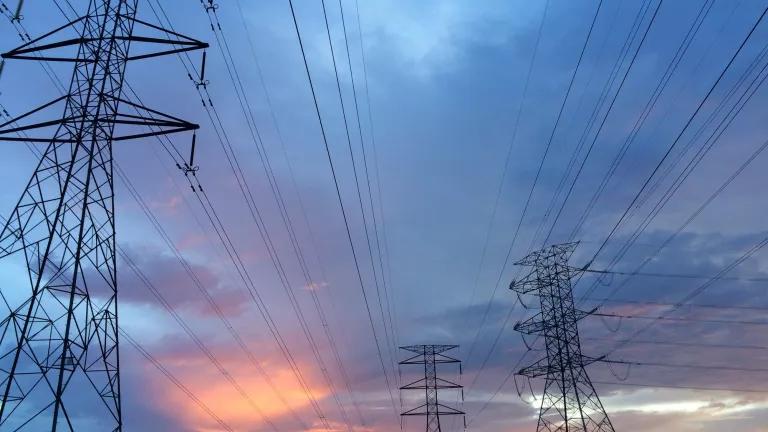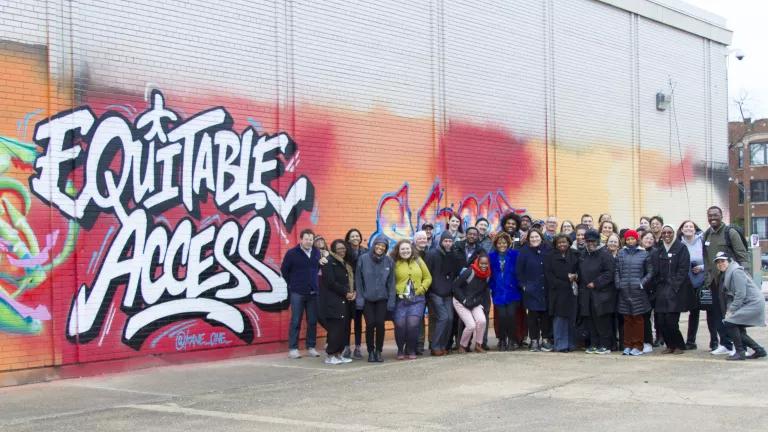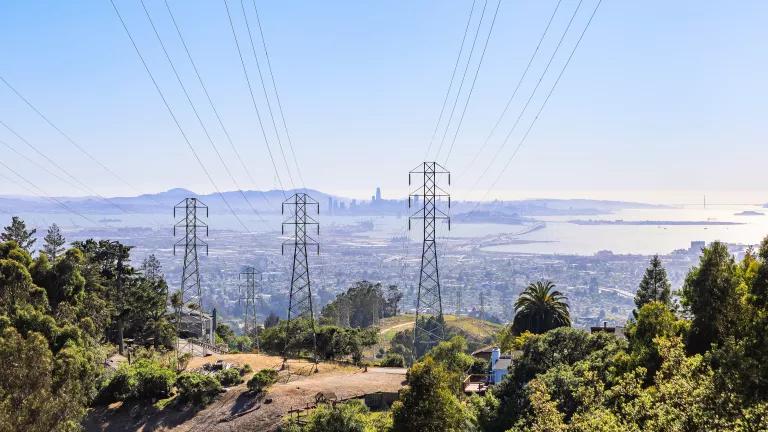Building a Better (and Cleaner!) Electric Grid
Both Congress and federal regulators have before them proposals that will jump-start construction of transmission lines, which are key to enabling the transition to clean energy. A new analysis shows the tremendous climate benefits of building out the electric grid.

Transmission lines are crucial to bring more clean energy on to the electric grid.
Many people have wondered how we will decarbonize our grid given the fact that the wind doesn’t always blow and the sun doesn’t always shine. One key part of the answer is clear: Both Congress and federal regulators have before them proposals that will jump-start construction of transmission lines, which are key to enabling the transition to clean energy.
The Build Back Better agenda in Congress includes expanding a key tax incentive (the Investment Tax Credit or ITC) that would help get $30 billion in transmission lines built across the nation. A new analysis from the research firm Grid Strategies shows that transmission lines provide enormous carbon-saving benefits.
Building 22 new transmission lines and operating them for the next 50 years could lead to total emissions reductions of about 6.4 billion tons of carbon dioxide, which is roughly equal to the total yearly amount of greenhouse gas emissions for the entire U.S.
In other words, building just key transmission projects would enable a massive cut in greenhouse gas emissions. To paraphrase President Biden, that’s a very big deal.
Why would this happen? There are two reasons. First, building new transmission lines facilitates the construction of wind and solar power in places that are windy and sunny. These areas are often far from the population centers with the most electricity demand—and so we need transmission superhighways to get this electricity to where it’s needed.
While a recent Washington Post story focused on New York’s dependence on the variable winds off of Lake Ontario, with new transmission lines the Big Apple could get solar power from Georgia or wind power from North Dakota—or, as the state is currently planning to do, offshore in the Atlantic Ocean.
In short, while wind and solar output may vary at the local level, transmission helps balance the power grid as a whole by aggregating diverse sources of supply and demand. The bottom line is that more transmission lines enable a more resilient, nimble grid. (Just ask Texas.)
Second, these power lines will allow existing solar and wind power to operate more frequently by ensuring the existing lines aren’t overwhelmed during particularly windy or sunny periods. Constructing more lines to better connect existing wind and solar resources would increase their output by more than 25%, according to data from the National Renewable Energy Laboratory.
A Jobs and Economic Winner
What makes this even more of a win is that even ignoring the climate benefits, building these long-haul power lines is a net benefit to our economy, lowering energy costs for consumers and making power supplies more resilient while creating tens of thousands of well-paying jobs here in the U.S.
“Transmission more than pays for itself by providing consumers with access to lower cost electricity,” Michael Goggin, the author of the Grid Strategies analysis, wrote.
FERC’s Key Role
In addition to congressional action, we need the Federal Energy Regulatory Commission to put in place rules that will enable the construction of new regional and interregional transmission lines. FERC is in the process of considering new rules on how it can overcome existing barriers and get these transmission lines built. In response to FERC’s proposal, a broad coalition of environmental groups has weighed in with extensive comments detailing the widespread planning failures in many parts of the country and the many ways FERC can address them. These reforms include:
- Creating independent transmission monitors to oversee the process of constructing these lines and interregional planning boards to plan upgrades across different planning regions.
- Requiring minimum planning standards: many grid upgrades don’t happen enough though the benefits of the upgrades far outweigh the costs. FERC needs to fix this myopic approach.
- Mandating that regions plan for a wider range of grid needs in the future, and use more realistic forecasts of future energy demand and renewable energy development.
- Ensuring that grid planners take a regional approach to planning rather than simply replacing existing lines. In other words, they need to plan for the future rather than the past.
- Engaging with states, many of which are pushing for climate action and cleaner energy, to ensure that these lines are sited properly and equitably.
(My colleague John Moore has more on this FERC rulemaking here.)
It’s clear that we are in the early stages of a monumental transformation in the way we generate electricity in our nation—and around the world. Solar and wind energy is now cheaper than energy derived from nuclear or coal, and clean energy facilities already are supplanting existing dirty, costlier fossil fuel plants. This renewable energy can transform our nation, generating not only clean electricity but millions of good-paying jobs to go along with it.
Enabling this transition requires a dramatic expansion of our electric grid. With the proposed investments from the Build Back Better legislation being considered in Congress and new rules from FERC, we can get the grid we need. We know how to do this. We just need the will to get it done.


